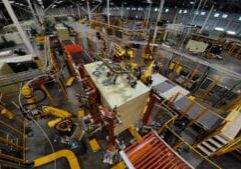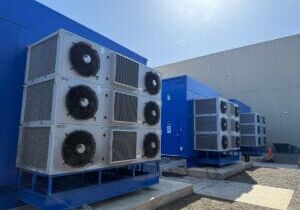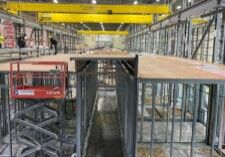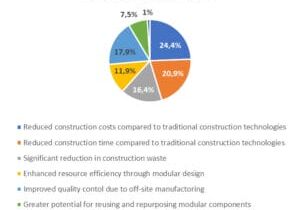Is the World Deglobalizing?
A new report from Anirban Basu, chairman & CEO of Sage Policy Group and Chief Economist of the Modular Building Institute

Anirban Basu is chairman & CEO of Sage Policy Group and Chief Economist of the Modular Building Institute
International Trade Matters as Much as Ever
There is a popular narrative indicating that the world is now splintering after a period of coming together. For decades, the world seemed destined to become a unified production unit. Dozens of free trade agreements, the expansion of World Trade Organization (WTO) membership, and import/export data suggested that national boundaries were falling, at least with respect to the movement of goods, including productive construction inputs.
According to the World Trade Organization’s Regional Trade Agreements Database, there are nearly 600 trade agreements in force around the world. The most common are free trade agreements between nations, but many also go so far as to support economic integration. The U.S. is party to 14 such agreements, including bilateral agreements with the Republic of Korea, Israel, and Chile. But the most important of these agreements is the US-Mexico-Canada agreement or USMCA.

Anirban Basu speaks at MBI's annual World of Modular conference and tradeshow.
Despite trade wars and other forms of conflict, the value of global merchandise trade expanded 12 percent last year to US$ 25.3 trillion, inflated in part by elevated global commodity prices. WTO economists have estimated that merchandise trade volume growth will approach 2 percent this year and then rebound to 3.2 percent in 2024. In short, global trade remains a massive and global force. For MBI members, this means that global supply chains and their degree of functioning will continue to matter even as America seeks to restore various supply chains, including those related to computer chip and battery production.
The Current State of Global Supply Chains
As of this writing, the conflict in Ukraine enters its 17th month. With fighting spilling into Russia, the U.S. and its allies pledging additional military and financial aid to Ukraine, the impacts of the war can be felt everywhere and are spreading, but most particularly in Europe.
An interesting implication has been the further elevation of the importance of natural gas. Economic sanctions placed on Russia by the U.S. among others have forced the balance of Europe to turn to alternative energy sources. Enter liquefied natural gas (LNG). According to Glenn Rickson of S&P Global Commodity Insights, “[Natural gas] is like oil in that it’s now a global commodity via LNG and has a much higher geopolitical significance because of the events of the past year”. He added, “It is also now arguably a higher value product than oil.”
With Covid disrupting supply chains and a war in Eastern Europe following hot on its heals, it comes as no surprise that global supply chains were massively disrupted. As vaccines became widely available in the U.S. and the economy reopened in fits and starts, consumer demand surged. As indicated by the Council on Foreign Relations, “at the same time, companies in critical sectors such as warehousing struggled to attract and retail workers.
These factors, combined with years of underinvestment in U.S. infrastructure, saw goods-laden containers piling up at major ports and ships waiting for weeks to dock.”
It appears that late-2021 represented the worst for such issues. Since then, supply chains have been in recovery mode, helping to drive down many costs, including energy and other construction input costs. The New York Fed’s Global Supply Chain Pressure Index (GSCPI) indicates that in May global supply chains experienced the least pressure of any month since the start of the data series in 1997 (though the GSCPI did increase slightly in June).
Freight rate data coincide with this finding. International container rates have declined 88 percent since their peak in late 2021 according to the Freightos Baltic Index. North American truck freight rates are down more than 10 percent over the past year according to the Cass Freight Index. All things being equal, such dynamics support construction industry profitability, including within its modular building segment.
International Manufacturing
Supply chain functioning is set to improve over the next several quarters, but this has little if anything to do with supply. Weakening demand for goods in the U.S. and elsewhere will generate less pressure on manufacturers and distributors, helping to speed up delivery times.
According to S&P Global data and the Institute for Supply Management (ISM), America’s manufacturing sector is contracting in the context of rising inventory levels. A CNN report from June noted that the U.S. manufacturing sector contracted in May according to S&P Global data. ISM data indicate that the industry has been contracting for seven months. Durable goods orders have been rising in recent months, however, in large measure because of the volatile transportation sector.
In Europe, recent economic numbers point to recession for the continent’s largest economies. Reuters reported in late-July that both French and German economies are contracting. High interest rates promulgated by the European Central Bank have waylaid consumers and diminished economy activity. A Purchasing Managers’ Index covering the euro zone indicates that manufacturing activity contracted in July at its fastest pace since Covid.
And then there’s China. Global factory activity continues to slump according to many private surveys, with economists increasingly concluding that slowing growth and broadening economic weakness in China are taking a toll on the global economy. As reported by Reuters, S&P Global’s gauge of worldwide manufacturing activity stood at 48.7 in July, matching its lowest level since June 2020 when Covid was still undoing international commerce. The subindices of factory output and new orders both slipped to six month lows.
Looking Ahead
After enjoying a period of robust demand for their output, many manufacturers around the world are struggling to generate orders. Not only will that place downward pressure on prices, it will induce faster delivery times, including for input-purchasing modular builders.
At the same time, America is rebuilding critical supply chains, eventually expanding domestic production and simplifying logistics. Many of the headlines focus on the reshoring of electronics and inputs to alternative energy. Nonetheless, the trend toward reshoring is more general in nature, and should help modular builders more easily source key inputs, including sustainable timber.
At the same time, certain construction segments that tend to utilize modular building services frequently enjoy solid prospects, including single-family homebuilding, education, and healthcare. While certain key commercial real estate segments may exhibit profound weakness and risk of recession remains elevated, at this point, based on supply and demand fundamentals, the outlook for modular building appears solid.
More from Modular Advantage
Resia: Breaking All the Rules
Resia Manufacturing, a division of U.S.-based Resia, is now offering prefabricated bathroom and kitchen components to industry partners. Its hybrid fabrication facility produces more precise bathroom and kitchen components (modules) faster and at lower cost than traditional construction. Here’s how Resia Manufacturing does it.
How LINQ Modular Innovates to Bring Modular To The Market in the UAE and Beyond
LINQ Modular, with an office and three manufacturing facilities in Dubai, is a modular firm based in United Arab Emirates. The company is on a mission: to break open the housing and construction markets in the Gulf Cooperation Council (GCC) area with modular.
ModMax: Redefining Modular Construction with Confidence and Precision
ModMax was born out of frustration—frustration with five persistent pain points in modular construction: Permitting bottlenecks. Production delays. Rigid designs. Disconnect between “the office” and the field. Lack of transparency and communication.
LifeArk: Disaster-Resilient Housing from Recycled Plastic and 100-year-old Technology
Wee compares LifeArk’s housing units to Yeti coolers, as they are built similarly. Each component takes 15 to 20 minutes to manufacture, has an R-value of 40, and includes molded slots and chases for wiring, plumbing, fire sprinklers, and other utilities.
Building the Future of Modular Edge Infrastructure
The edge data center market is expanding rapidly, driven by the surge in AI workloads, IoT adoption, and the need for localized compute power. In these environments, sustainability, scalability, and reliability are non-negotiable. Cooling is among the most complex challenges for operators—and one of the most decisive factors in long-term success.
Accelerating Light-Gauge Steel Construction: A Semi-Automated Digital Workflow for Off-Site Projects
For construction professionals, the message is clear. By adopting semi-automation and digitalization, companies can deliver projects faster, more accurately, and more profitably, while also building stronger collaboration across teams. The approach is not about replacing people with machines, but about empowering people with better tools and processes.
Why Modular Data Centers Are Gaining Momentum
Artificial intelligence, high-performance computing, and edge applications push the limits of traditional “stick-built” data centers. They take years build, often struggle with high density workloads, and aren’t optimized for deployments near end users. Modular data center platforms are purpose-built to address these challenges, offering flexibility and scalability to adapt to evolving technologies, while opening new opportunities for the modular construction industry.
Supply Chain Innovation in Action: 5 Habits Every Modular Leader Should Practice
By applying these principles to supply chain practices — collaborative planning, strategic procurement, scenario modeling, digital tools, and transparent forecasting — construction leaders can build value chains that are not just efficient and agile, but truly innovative.
Exploring the Role of Modular Integrated Construction (MiC) in Advancing Circular City Principles – A Survey of Stakeholder Perspectives
The survey findings highlight the significant potential of Modular integrated Construction (MiC) in advancing the development of circular cities. By reducing costs, accelerating construction timelines, and minimizing waste generation, MiC offers a promising approach to sustainable urban development.
The Use of MS POLYMER™-Based Sealants and Adhesives in Modular Building
These products combine flexibility and elastic recovery with excellent adhesion to different substrates and have already shown their usefulness in traditional construction. Now it’s time for them to be put to use in the modular construction industry.










